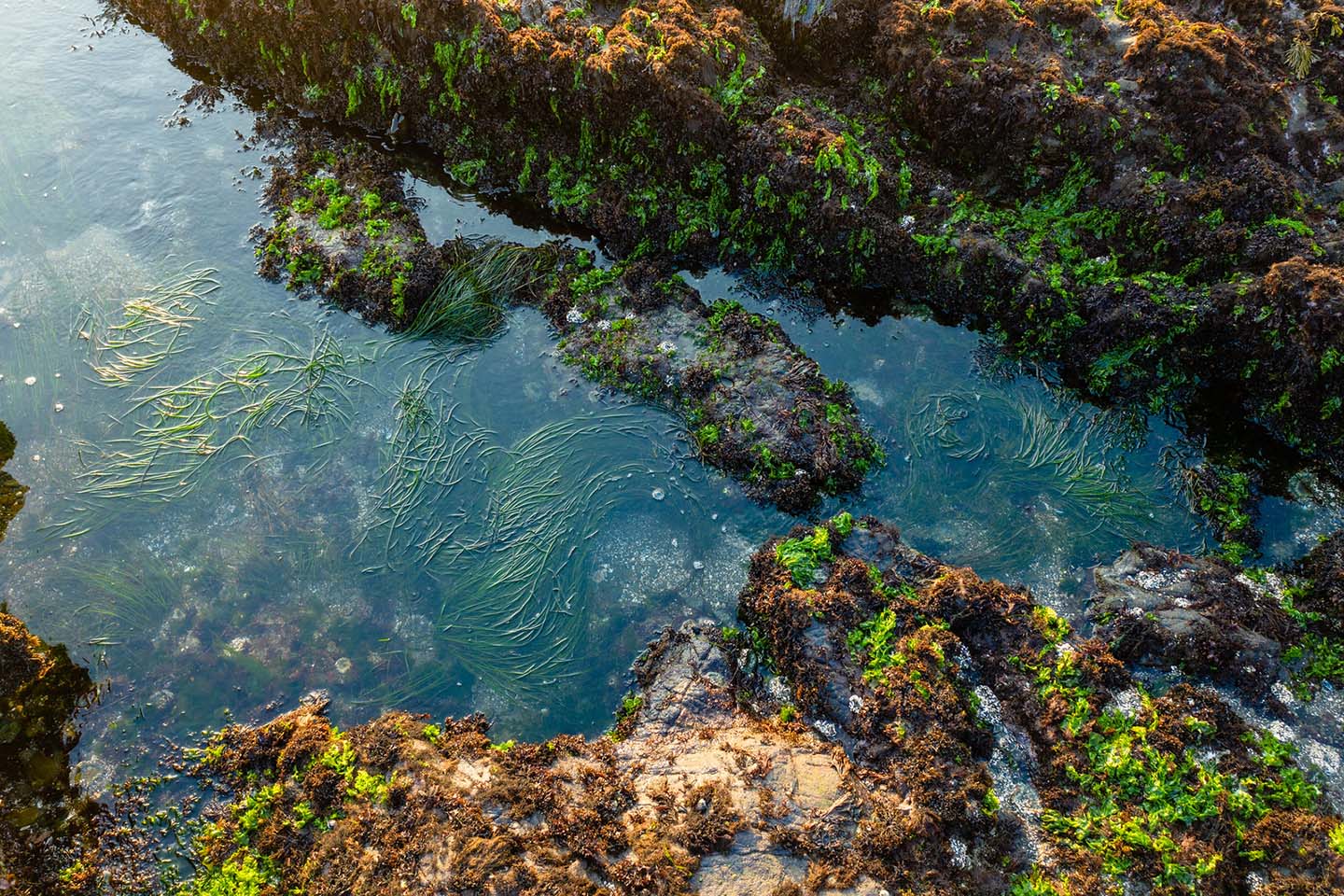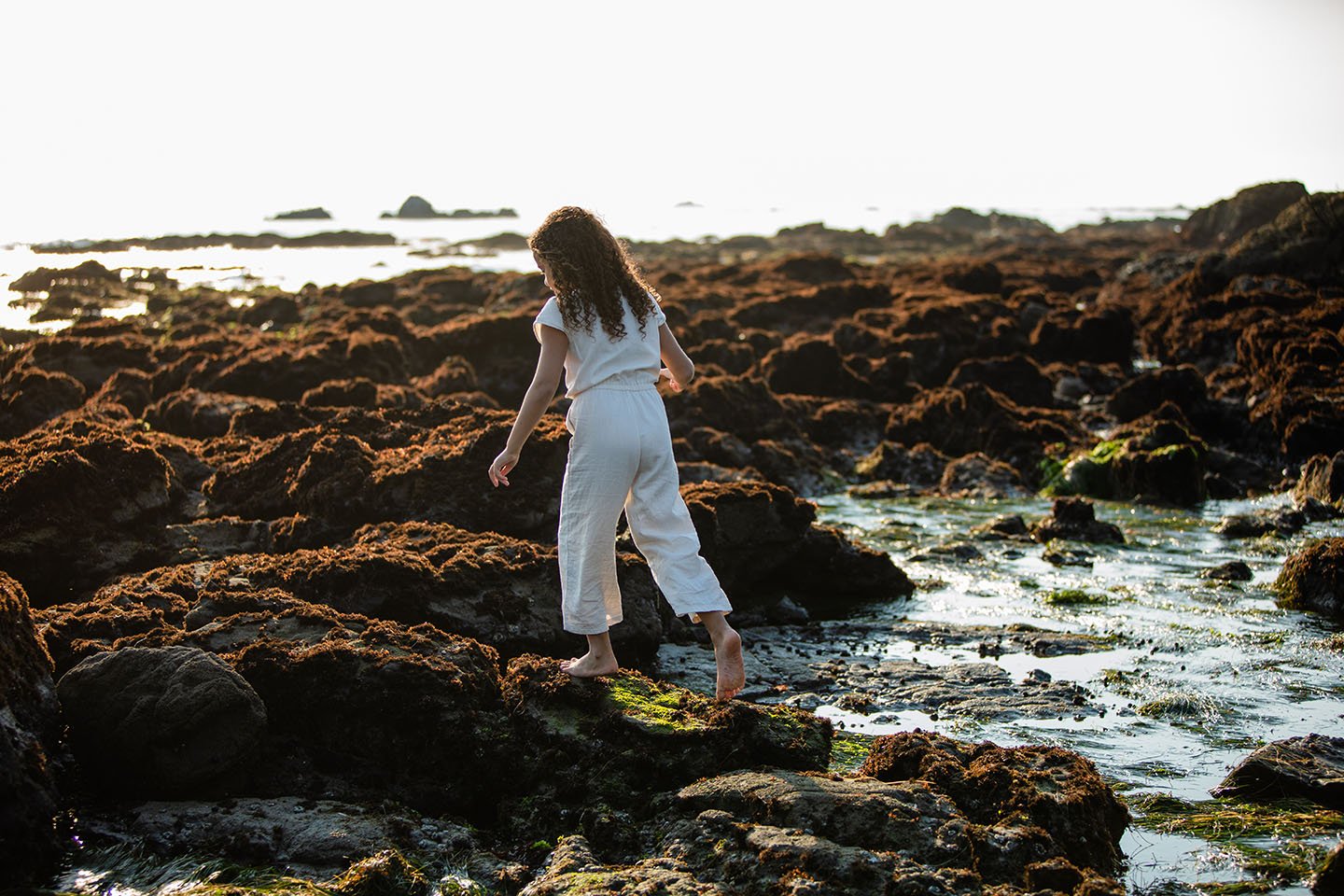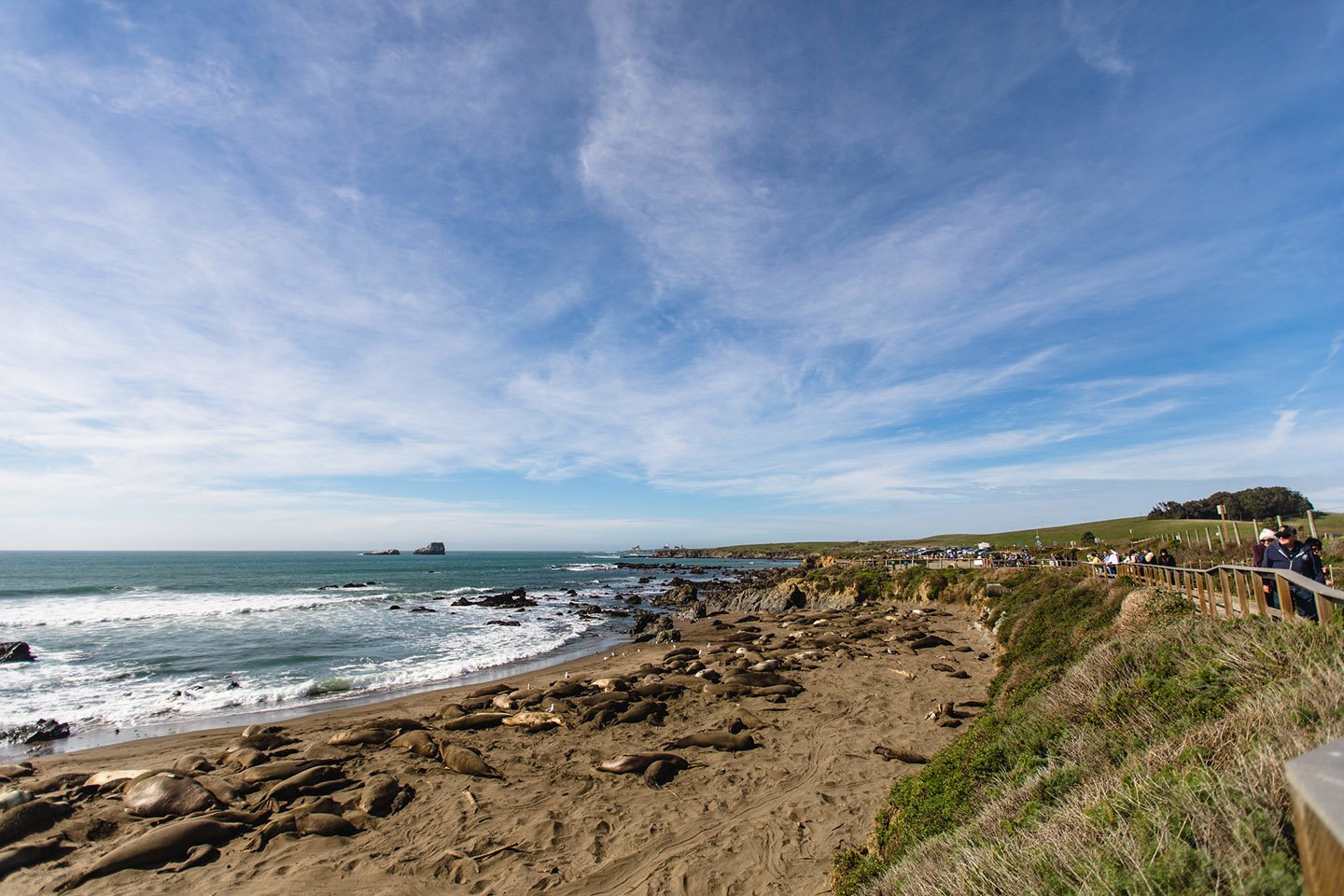Tide Pools and Sea Life
Tide Pools and Sea Life of San Simeon
See San Simeon’s marine wildlife for yourself at some of the most diverse sea life viewing sites on the entire Central Coast. Home to abundant wildlife, tide pools are the perfect place to get up close with nature! Find saltwater mussels hiding among the rocks, discover vibrant starfish making their way along stretches of sandbars, or simply watch the sea anemone ebb and flow with the tide. No matter what you’re looking for, the tide pools are teeming with plenty of sea life to observe and explore.
San Simeon encompasses both the Monterey Bay National Marine Sanctuary and the Piedras Blancas State Marine Reserve and Conservation Area. The Monterey Bay National Marine Sanctuary is one of the nation's most spectacular marine protected areas. The area stretches 276 miles of shoreline from San Francisco to Cambria. Often referred to as the “Serengeti of the Sea,” this coastal treasure serves as a sanctuary to over 36 species of marine mammals, more than 180 species of seabirds and shorebirds, at least 525 species of fishes, and an abundance of invertebrates and algae. The Piedras Blancas State Marine Reserve and Conservation Area are two marine protected areas that encompass rich shorelines and tidepools. The habitat historically supports everything from sea otters to migratory gray whales. The area is also notably home to the Piedras Blancas Elephant Seal Rookery, where you’ll experience the very best elephant seal viewing.
The Coastal Discovery Center
The Coastal Discovery Center, located at W.R. Hearst Memorial State Beach, is a great starting point for any coastal adventure in the area. Choose between self-guided and professionally guided tours to get the most out of your seaside experience. Check out a pair of binoculars and set off on a self-guided tour of the pier and surrounding beaches. Signs will provide information on native birds and mammals as you stroll along the coast. With a guided tour, a professional guide will lead you along the pier and across the beach where you will learn about the history and have an opportunity to comb the beach. Whichever tour you choose, be sure to keep an eye on the tide as harbor seals are commonly spotted in the water around the pier.
Explore Tide Pools and Sea Life Along Highway 1
San Simeon Tide Pools

North of Piedras Blancas Light Station
- The Point Sierra Nevada Trailhead South offers easy access to Arroyo Laguna Beach and a variety of tide pools during low tide.
- The Northernmost Boucher Trailhead offers access to the beach just north of Piedras Blancas which has a great tide pool selection on the north side of the beach. Our local residents, the elephant seals sometimes come ashore in this area. Make sure to respect the wildlife and give the elephant seals a wide berth.
Vista Point South of Piedras Blancas
- Conveniently located, just turn off from the scenic Highway 1 for a quick tide pool tour. If you find yourself cruising down the Coastal Discovery Route around low tide— (early afternoons and early mornings) be sure to stop by!
W.R. Hearst Memorial State Beach
- Tide pools here are generally small, and only visible during low tide at the northern side of the beach but still a great introduction to sea life.

Tide Pool Critters
Anemones - A close relative of coral and jellyfish, sea anemones attach themselves to rocks in tide pools or on coral reefs waiting for small fish to pass close enough to reel in with their stinging tentacles.
Barnacles – These little fellows have a hard-outer shell, similar to crabs, but use their legs to eat. The legs, or Cirri, trap food beneath the shell to feed the barnacle.
Crabs – Crab shells come in all shapes, sizes and colors, including white, tan, green and brown. These crustacean move around on eight legs, primarily using the larger front legs to eat and defend against predators.
Fish – The most common fish found in tide pools are Sculpins and Opaleyes, ranging from 3-5 inches in length. They are well camouflaged, so look closely for these fish swimming near the rocks!
Mussels and Clams – These critters spend up to half their day exposed to air when the tide recedes, surviving by sealing their shells shut with seawater trapped inside. When the tide rolls back in, the mussels and clams open their shells to allow food and fresh seawater to enter.
Sea Slug – The sea slug is very similar to a garden slug, but instead of lungs the sea slug has gills. These slimy critters spend their days feeding on red and brown algae found in the tide pools.
Sea Stars – These beautiful creatures range in colors from bright orange to soft pink. Sea stars have five arms, with tubes on their body strong enough to open mussels and clams to feed on.
Snails – Marine snails are categorized into two groups, herbivores and carnivores. Both types of snails use a sharp tooth that they use to scrape algae off of rocks or drill into an animal’s shell.
Urchins – The sea urchin is completely covered in spines with the purpose of protecting, feeding and creating a home. While the spines look intimidating, they do not hold any venom.

Wildlife Viewing at Point Piedras Blancas
The West Overlook Stop, the Westernmost point of the Light Station, provides a view of offshore rocks where harbor seals, sea lions, cormorants, pelicans and even peregrine falcons shelter. A unique viewing experience where you can see a wide variety of marine life in just one spot.
Offshore white rocks (Piedras Blancas translates to “White Rocks”) provide a resting area for marine birds and mammals. Here you will find a range of animals particularly in nesting seasons.
The Whale Stop along Boucher Trail provides an amazing wide sweeping view of one of the areas that whales most often breach the surface. This stop provides you with the best chance to see a whale spout or tail (and hopefully to snap a quick pic!)
The Otter Stop along Boucher Trail provides a view of the cove area where otters often play. California sea otters are one of the smallest local mammals, so bring your binoculars to spot these furry little friends!
Elephant Seal Viewing

Elephant seals are easily one of San Simeon’s most sought-after attractions, as the beaches here are the best place to view them year-round. These charismatic creatures can be seen inhabiting the beach at the Piedras Blancas Rookery by the thousands, particularly in January and February for birthing and breeding season. The Northern Elephant Seal is known for their impressive size and males can weigh up to 5,000 pounds! Being the second largest seal in the world, alongside their loud barking, earn them their name. You won’t want to miss this unique viewing experience. While at the rookery, look for The Friends of the Elephant Seal docents wearing blue jackets, they’ll be ready to answer all of your elephant seal questions.
Fun Facts About Elephant Seals
- Elephant seals get their name from their enormous size and the male’s enlarged nose that resembles an elephant trunk (called a proboscis)
- Northern Elephant Seals, like the ones seen on San Simeon’s beaches, are primarily found along the North Pacific coast
- Northern Elephant Seals are slightly smaller than their Southern counterparts, making them the second largest seal in the world
- Elephant seals spend up to 80% of their lives in the open ocean, returning to shore twice a year to breed and molt
- Elephant seals can live anywhere between 14-20 years old, females living to be the oldest
- They can hold their breath for an impressive 100 plus minutes
- Their diet is mostly made up of squid and fish, but they may also eat rays and sharks!
- They are capable of swimming up to 60 miles in one day
- Male elephant seals, called bulls, can weigh up to 5000 pounds
- Elephant seals nearly went extinct around 1890 after being over hunted for their oil-producing blubber
Whale Watching
Wave hello to migrating gray whales and minke whales, if you’re lucky you may even catch a glimpse of the occasional orca or humpback whale. In addition to the Whale Stop at Piedras Blancas, there are multiple elevated scenic viewing points along the San Simeon coastline that you can turn off and catch glimpses of whale’s breaching. The Whale Trail has identified the best whale viewing locations on the Central Coast. Not only are these great spots for viewing the whales but it is fully equipped with telescopes for close viewing and interactive signs for more information.
Fun Facts About Whales
- The best time to spot whales is when the wind and sea are calm, generally in the early morning and an hour or so before sunset.
- Whales don’t sleep the way other mammals do, or they would drown. Instead, whales shut down only a portion of their brain when they rest.
- Orca whales, also known as killer whales, are known for hunting great white sharks.
- Despite the name killer whale, orcas are actually the largest member of the dolphin family.
- Gray whales make one of the longest annual migrations of any mammal, traveling as far as 10,000 miles.
- Humpback whales can live up to 90 years old!
- Humpback whales are filter feeders, filtering up to 3000 pounds of krill and small fish into their mouths each day.
- Minke whales are the smallest of the fin whales, but their vocalizations are as loud as a jet plane taking off!
Wildlife Viewing Tips
Respect - Remember to respect wildlife by keeping your distance and staying quiet. Fast movements and loud noises can startle the animals. If you bring along your pet, make sure to keep them leashed by your side at all times.
Protect - Observe with your eyes not your hands. Bring a pair of binoculars or a zoom camera to get a closer look! Never touch or feed the wildlife.
Preserve - Leave it the way you found it. Keep San Simeon beautiful by picking up after yourself and not leaving any trash behind.
